Data Structures | Assignments
Data Structures - Assignments
In Emertxe each one of our Data Structures Algorithm Examples will ensure you apply the concept you have leant in your classroom. By solving these Data Structures Exercises, you will go through a systematic problem-solving approach which include requirement understanding, algorithm design, pseudocode creation, dry run and final execution. As you move from simple to more complex data Structures Exercises of each module it will slowly start building your self-confidence.
Chapter 1 : Single Linked List
| Title | Insert After | |||||||||||
|---|---|---|---|---|---|---|---|---|---|---|---|---|
| Filename | sl_insert_after.c | |||||||||||
| Description | Write a function to insert the new data after the given data using Data Structure Algorithm Examples | |||||||||||
| Cases |
| |||||||||||
| Case-1 | List Empty | |||||||||||
| Input | Head = NULL | |||||||||||
| Output | return LIST_EMPTY | |||||||||||
| Case-2 Sub-case:1 | List Non-Empty Given data present | Case-2 Sub-case:2 | List Non-Empty Given data not present | |||||||||
| Example | If given_data = 40, new_data = 45 | Example | If given_data = 60, new_data = 45 | |||||||||
| Input | 10 -> 20 -> 30 -> 40 -> 50 | Input | 10 -> 20 -> 30 -> 40 -> 50 | |||||||||
| Output | 10 -> 20 -> 30 -> 40 -> 45 -> 50 | Output | Return DATA_NOT_FOUND | |||||||||
| Prototype | int sl_insert_after(Slist *head, data_t g_data, data_t n_data);
| |||||||||||
| Title | Insert Before | |||||||||||
|---|---|---|---|---|---|---|---|---|---|---|---|---|
| Filename | sl_insert_before.c | |||||||||||
| Description | Write a function to insert the new data before the given data. | |||||||||||
| Cases |
| |||||||||||
| Case-1 | List Empty | |||||||||||
| Input | Head = NULL | |||||||||||
| Output | return LIST_EMPTY | |||||||||||
| Case-2 Sub-case:1 | List Non-Empty Given data present | Case-2 Sub-case:2 | List Non-Empty Given data not present | |||||||||
| Example | If given_data = 40, new_data = 45 | Example | If given_data = 60, new_data = 45 | |||||||||
| Input | 10 -> 20 -> 30 -> 40 -> 50 | Input | 10 -> 20 -> 30 -> 40 -> 50 | |||||||||
| Output | 10 -> 20 -> 30 -> 45 -> 40 -> 50 | Output | Return DATA_NOT_FOUND | |||||||||
| Case-3 | Data found in the first | |||||||||||
| Example | If given_data = 10, new_data = 45 | |||||||||||
| Input | 10 -> 20 -> 30 -> 40 -> 50 | |||||||||||
| Output | 45 -> 10 -> 20 -> 30 -> 40 -> 50 | |||||||||||
| Prototype | int sl_insert_after(Slist **head, data_t g_data, data_t n_data);
| |||||||||||
| Title | Delete element | |||||||||
|---|---|---|---|---|---|---|---|---|---|---|
| Filename | sl_delete_element.c | |||||||||
| Description | Write a function to delete the given data in the single linked list. | |||||||||
| Cases |
| |||||||||
| Case-1 | List Empty | |||||||||
| Input | Head = NULL | |||||||||
| Output | return LIST_EMPTY | |||||||||
| Case-2 Sub-case:1 | List Non-Empty Given data present | Case-2 Sub-case:2 | List Non-Empty Given data not present | |||||||
| Example | If given_data = 40 | Example | If given_data = 60 | |||||||
| Input | 10 -> 20 -> 30 -> 40 -> 50 | Input | 10 -> 20 -> 30 -> 40 -> 50 | |||||||
| Output | 10 -> 20 -> 30 -> 50 | Output | Return DATA_NOT_FOUND | |||||||
| Prototype | int sl_insert_after(Slist **head, data_t g_data);
| |||||||||
| Title | Insert at ‘n’ position | |||||||||||
|---|---|---|---|---|---|---|---|---|---|---|---|---|
| Filename | sl_insert_nth.c | |||||||||||
| Description | Write a function to insert the given data exactly at the ‘n’ position in the single linked list. incorporating essential data structure algorithm examples for better understanding. | |||||||||||
| Cases |
| |||||||||||
| Case-1 | List Empty | |||||||||||
| Input | Head = NULL | |||||||||||
| Output | return LIST_EMPTY | |||||||||||
| Case-2 Sub-case:1 | List Non-Empty Given data present | Case-2 Sub-case:2 | List Non-Empty Given data not present | |||||||||
| Example | If n = 3, n_data = 23 | Example | If n = 10, n_data = 23 | |||||||||
| Input | 10 -> 20 -> 30 -> 40 -> 50 | Input | 10 -> 20 -> 30 -> 40 -> 50 | |||||||||
| Output | 10 -> 20 -> 23 -> 30 -> 50 | Output | Return POSITION_NOT_FOUND | |||||||||
| Prototype | int sl_insert_after(Slist **head, int n, data_t n_data);
| |||||||||||
| Title | Find Mid | |||||||||
|---|---|---|---|---|---|---|---|---|---|---|
| Filename | sl_find_mid.c | |||||||||
| Description | Write a function to find the mid node in the given linked list. Accompained by data structure algorithm example. | |||||||||
| Cases |
| |||||||||
| Case-1 | List Empty | |||||||||
| Input | Head = NULL | |||||||||
| Output | return LIST_EMPTY | |||||||||
| Case-2 Sub-case:1 | List Non-Empty List contains Odd nodes | Case-2 Sub-case:2 | List Non-Empty List contains Even nodes | |||||||
| Input | 10 -> 20 -> 30 -> 40 -> 50 | Input | 10 -> 20 -> 40 -> 50 | |||||||
| Output | 30 | Output | 20 | |||||||
| Prototype | int sl_find_mid(Slist *head, Slist **mid);
| |||||||||
| Note | Traverse the linked list only once | |||||||||
| Title | Get nth node from last | |||||||||||
|---|---|---|---|---|---|---|---|---|---|---|---|---|
| Filename | sl_get_nth_from_last.c | |||||||||||
| Description | Write a function to get the nth node from the end of the linked list. a common problem in data structure algorithms examples. | |||||||||||
| Cases |
| |||||||||||
| Case-1 | List Empty | |||||||||||
| Input | Head = NULL | |||||||||||
| Output | return LIST_EMPTY | |||||||||||
| Case-2 | List Non-Empty | |||||||||||
| Input | 10 -> 20 -> 30 -> 40 -> 50, n = 2 | |||||||||||
| Output | 40 (From the last, second node conatins the data 40) | |||||||||||
| Prototype | int sl_get_nth_from_last(Slist *head, int n);
| |||||||||||
| Title | Insert Sorted | |||||||||
|---|---|---|---|---|---|---|---|---|---|---|
| Filename | sl_insert_sorted.c | |||||||||
| Description | Write a function to insert the new data in the already sorted linked list | |||||||||
| Cases |
| |||||||||
| Case-1 | List Empty | |||||||||
| Input | Head = NULL | |||||||||
| Output | return LIST_EMPTY | |||||||||
| Case-2 | List Non-Empty | |||||||||
| Example | If n_data = 45 | |||||||||
| Input | 10 -> 20 -> 30 -> 40 -> 50 | |||||||||
| Output | 10 -> 20 -> 30 -> 40 -> 45 -> 50 | |||||||||
| Prototype | int sl_insert_after(Slist **head, data_t n_data);
| |||||||||
| Title | Find loop | |||||||
|---|---|---|---|---|---|---|---|---|
| Filename | sl_find_loop.c | |||||||
| Description | Write a function to detect whether the given linked list is ending with loop or not incorporating data structure algorithm examples to illustrate practical implementation | |||||||
| Cases |
| |||||||
| Case-1 | List Empty | |||||||
| Input | Head = NULL | |||||||
| Output | return LIST_EMPTY | |||||||
| Case-2 Sub-Case:1 | List Non-Empty | |||||||
| Input |  | |||||||
| Output | Loop detected. | |||||||
| Case-2 Sub-Case:2 | List Non-Empty | |||||||
| Input |  | |||||||
| Output | Loop not detected. | |||||||
| Prototype | int sl_insert_after(Slist *head);
| |||||||
| Note | Traverse the linked list only once | |||||||
| Title | Sort | ||||
|---|---|---|---|---|---|
| Filename | sl_sort.c | ||||
| Description | Write a function to sort the given single linked list. | ||||
| Cases |
| ||||
| Case-1 | List Empty | ||||
| Input | Head = NULL | ||||
| Output | return LIST_EMPTY | ||||
| Case-2 | List Non-Empty | ||||
| Input | 50 -> 40 -> 30 -> 20 -> 10 | ||||
| Output | 10 -> 20 -> 30 -> 40 -> 50 | ||||
| Prototype | int sl_sort(Slist **head);
| ||||
| Note | Don’t swap the data present in the nodes, swap the nodes itself. |
| Title | Reverse | |||||||
|---|---|---|---|---|---|---|---|---|
| Filename | sl_reverse_iterative.c sl_reverse_recursive.c | |||||||
| Description | Write a function to reverse the single linked list in both iterative and recursive methods | |||||||
| Cases |
| |||||||
| Case-1 | List Empty | |||||||
| Input | Head = NULL | |||||||
| Output | return LIST_EMPTY | |||||||
| Case-2 | List Non-Empty | |||||||
| Input | 50 -> 40 -> 30 -> 20 -> 10 | |||||||
| Output | 10 -> 20 -> 30 -> 40 -> 50 | |||||||
| Prototype | int sl_sort(Slist **head);
| |||||||
| Title | Reverse | |||||||
|---|---|---|---|---|---|---|---|---|
| Filename | sl_reverse_iterative.c sl_reverse_recursive.c | |||||||
| Description | Write a function to reverse the single linked list in both iterative and recursive methods, incorporating data structure algorithm examples to illustrate the implementation process. | |||||||
| Cases |
| |||||||
| Case-1 | List Empty | |||||||
| Input | Head = NULL | |||||||
| Output | return LIST_EMPTY | |||||||
| Case-2 | List Non-Empty | |||||||
| Input | 50 -> 40 -> 30 -> 20 -> 10 | |||||||
| Output | 10 -> 20 -> 30 -> 40 -> 50 | |||||||
| Prototype | int sl_sort(Slist **head);
| |||||||
| Title | Remove Duplicates | |||||||
|---|---|---|---|---|---|---|---|---|
| Filename | sl_remove_duplicates.c | |||||||
| Description | Write a function to remove the duplicates data present in the single linked list, implementing a data structure algorithm example for efficient removal of duplicates | |||||||
| Cases |
| |||||||
| Case-1 | List Empty | |||||||
| Input | Head = NULL | |||||||
| Output | return LIST_EMPTY | |||||||
| Case-2 | List Non-Empty | |||||||
| Input | 5 -> 3 -> 4 -> 5 -> 2 -> 1 -> 4 -> 5 -> 3 | |||||||
| Output | 5 -> 3 -> 4 -> 2 -> 1 | |||||||
| Prototype | int sl_sort(Slist **head);
| |||||||
| Title | Sorted Merge | |||||||||
|---|---|---|---|---|---|---|---|---|---|---|
| Filename | sl_sorted_merge.c | |||||||||
| Description | Write a function to merge two linked list into one | |||||||||
| Cases |
| |||||||||
| Case-1 | List Empty | |||||||||
| Input | Head = NULL | |||||||||
| Output | return LIST_EMPTY | |||||||||
| Case-2 | List Non-Empty | |||||||||
| Input | List – 1 30 -> 10 -> 50 List – 2 20 -> 5 -> 35 | |||||||||
| Output | 5 -> 10 -> 20 -> 30 -> 35 -> 50 | |||||||||
| Prototype | int sl_sort(Slist **head1, Slist **head2);
| |||||||||
| Note |
| |||||||||
Chapter 2 : Double Linked List
| Title | Insert After | |||||||||||
|---|---|---|---|---|---|---|---|---|---|---|---|---|
| Filename | dl_insert_after.c | |||||||||||
| Description | Write a function to insert the new data after the given data. | |||||||||||
| Cases |
| |||||||||||
| Case-1 | List Empty | |||||||||||
| Input | Head = NULL | |||||||||||
| Output | return LIST_EMPTY | |||||||||||
| Case-2 Sub-case:1 | List Non-Empty Given data present | Case-2 Sub-case:2 | List Non-Empty Given data not present | |||||||||
| Example | If given_data = 40, new_data = 45 | Example | If given_data = 60, new_data = 45 | |||||||||
| Input | 10 -> 20 -> 30 -> 40 -> 50 | Input | 10 -> 20 -> 30 -> 40 -> 50 | |||||||||
| Output | 10 -> 20 -> 30 -> 40 -> 45 -> 50 | Output | Return DATA_NOT_FOUND | |||||||||
| Prototype | int dl_insert_after(Dlist *head, data_t g_data, data_t n_data);
| |||||||||||
| Title | Insert Before | |||||||||||
|---|---|---|---|---|---|---|---|---|---|---|---|---|
| Filename | dl_insert_before.c | |||||||||||
| Description | Write a function to insert the new data before the given data. | |||||||||||
| Cases |
| |||||||||||
| Case-1 | List Empty | |||||||||||
| Input | Head = NULL | |||||||||||
| Output | return LIST_EMPTY | |||||||||||
| Case-2 Sub-case:1 | List Non-Empty Given data present | Case-2 Sub-case:2 | List Non-Empty Given data not present | |||||||||
| Example | If given_data = 40, new_data = 45 | Example | If given_data = 60, new_data = 45 | |||||||||
| Input | 10 -> 20 -> 30 -> 40 -> 50 | Input | 10 -> 20 -> 30 -> 40 -> 50 | |||||||||
| Output | 10 -> 20 -> 30 -> 45 -> 40 -> 50 | Output | Return DATA_NOT_FOUND | |||||||||
| Case-3 | Data found in the first | |||||||||||
| Example | If given_data = 10, new_data = 45 | |||||||||||
| Input | 10 -> 20 -> 30 -> 40 -> 50 | |||||||||||
| Output | 45 -> 10 -> 20 -> 30 -> 40 -> 50 | |||||||||||
| Prototype | int sl_insert_after(Dlist **head, data_t g_data, data_t n_data);
| |||||||||||
| Title | Delete element | |||||||||
|---|---|---|---|---|---|---|---|---|---|---|
| Filename | dl_delete_element.c | |||||||||
| Description | Write a function to delete the given data in the double linked list. | |||||||||
| Cases |
| |||||||||
| Case-1 | List Empty | |||||||||
| Input | Head = NULL | |||||||||
| Output | return LIST_EMPTY | |||||||||
| Case-2 Sub-case:1 | List Non-Empty Given data present | Case-2 Sub-case:2 | List Non-Empty Given data not present | |||||||
| Example | If given_data = 40 | Example | If given_data = 60 | |||||||
| Input | 10 -> 20 -> 30 -> 40 -> 50 | Input | 10 -> 20 -> 30 -> 40 -> 50 | |||||||
| Output | 10 -> 20 -> 30 -> 50 | Output | Return DATA_NOT_FOUND | |||||||
| Prototype | int sl_insert_after(Dlist **head, data_t g_data);
| |||||||||
Chapter 3 : Stacks
| Title | Infix to Postfix | |||||||
|---|---|---|---|---|---|---|---|---|
| Filename | infix_postfix.c | |||||||
| Description | Write a function to convert the given infix expression into the postfix form | |||||||
| Cases |
| |||||||
| Case-1 | Single digit numbers | |||||||
| Input | 2 * 3 – 3 + 8 / 4 / (1 + 1) | |||||||
| Output | 2 3 * 3 – 8 4 / 1 1 + / + | |||||||
| Case-2 | Multiple digit numbers | |||||||
| Input | 2 * 30 – 3 + 8 / 4 / (10 + 1) | |||||||
| Output | 2, 30, *, 3, –, 8, 4, /, 10, 1, +, / ,+ | |||||||
| Sample Prototype | Char * infix_postfix(char *infix);
| |||||||
| Title | Postfix Evaluation | |||||||
|---|---|---|---|---|---|---|---|---|
| Filename | postfix_eval.c | |||||||
| Description | Write a function to evaluate the postfix expression. | |||||||
| Cases |
| |||||||
| Case-1 | Single digit numbers | |||||||
| Input | 2 3 * 3 – 8 4 / 1 1 + / + | |||||||
| Output | 4 | |||||||
| Case-2 | Multiple digit numbers | |||||||
| Input | 2, 30, *, 3, –, 8, 4, /, 10, 1, +, / ,+ | |||||||
| Output | 57.181 | |||||||
| Sample Prototype | double infix_postfix(char *postfix);
| |||||||
| Title | Infix to Prefix | |||||||
|---|---|---|---|---|---|---|---|---|
| Filename | infix_prefix.c | |||||||
| Description | Write a function to convert the given infix expression into the prefix form | |||||||
| Cases |
| |||||||
| Case-1 | Single digit numbers | |||||||
| Input | 2 * 3 – 3 + 8 / 4 / (1 + 1) | |||||||
| Output | + – * 2 3 3 / / 8 4 + 1 1 | |||||||
| Case-2 | Multiple digit numbers | |||||||
| Input | 2 * 30 – 3 + 8 / 4 / (10 + 1) | |||||||
| Output | +, -, *, 2, 30, 3, /, /, 8, 4, +, 10, 1 | |||||||
| Sample Prototype | Char * infix_prefix(char *infix);
| |||||||
| Title | Prefix Evaluation | |||||||
|---|---|---|---|---|---|---|---|---|
| Filename | prefix_eval.c | |||||||
| Description | Write a function to evaluate the prefix expression. | |||||||
| Cases |
| |||||||
| Case-1 | Single digit numbers | |||||||
| Input | + – * 2 3 3 / / 8 4 + 1 1 | |||||||
| Output | 4 | |||||||
| Case-2 | Multiple digit numbers | |||||||
| Input | +, -, *, 2, 30, 3, /, /, 8, 4, +, 10, 1 | |||||||
| Output | 57.181 | |||||||
| Sample Prototype | double infix_postfix(char *prefix);
| |||||||
Chapter 4 : Sorting
| Title | Bubble Sort | |||||||
|---|---|---|---|---|---|---|---|---|
| Filename | bubble.c | |||||||
| Description | Write a function to sort given array using bubble sort | |||||||
| Input | 5 4 3 2 1 | |||||||
| Output | 1 2 3 4 5 | |||||||
| Sample Prototype | void bubble_sort(int *ptr)
| |||||||
| Title | Insertion Sort | |||||||
|---|---|---|---|---|---|---|---|---|
| Filename | insertion.c | |||||||
| Description | Write a function to sort given array using insertion sort | |||||||
| Input | 5 4 3 2 1 | |||||||
| Output | 1 2 3 4 5 | |||||||
| Sample Prototype | void insertion_sort(int *ptr)
| |||||||
| Title | Selection Sort | |||||||
|---|---|---|---|---|---|---|---|---|
| Filename | selection.c | |||||||
| Description | Write a function to sort given array using selection sort | |||||||
| Input | 5 4 3 2 1 | |||||||
| Output | 1 2 3 4 5 | |||||||
| Sample Prototype | void selection_sort(int *ptr)
| |||||||
Chapter 5 : Trees
| Title | Delete nodes | |||
|---|---|---|---|---|
| Filename | bst_delete_node.c | |||
| Description | Write a function to delete the given data from the bst | |||
| Cases | Node to be deleted may be,
| |||
| Case-1 | Leaf node | |||
| Input | 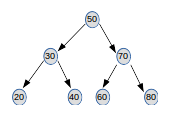 | |||
| Output | 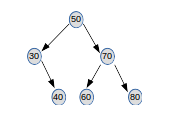 | |||
| Case-2 | Node with single child | |||
| Input | 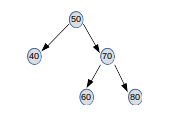 | |||
| Output | After deleting 30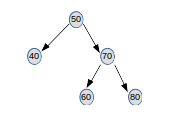 | |||
| Case-3 | Node with two children | |||
| Input |  | |||
| Output | After deleting 50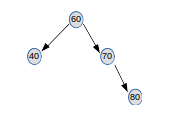 | |||
| Title | Find height | |||
|---|---|---|---|---|
| Filename | bst_find_height.c | |||
| Description | Write a function to find the height of the given tree | |||
| Cases |
| |||
| Case-1 | Tree Non-Empty | |||
| Input |  | |||
| Output | Height = 2 | |||
Chapter 6 : Hashing
| Title | Create hash table | |||
|---|---|---|---|---|
| Filename | create_hash_table.c | |||
| Description | Write a function to create the hash table | |||
| Input | Size | |||
| Output | Hash table with the given size | |||
| Title | Hash table search | |||
|---|---|---|---|---|
| Filename | hash_search.c | |||
| Description | Write a function to search the data in the hash table | |||
| Input | Hash Table | |||
| Output | Address of the node where data is found in the hash table | |||
| Title | Hash table insert | |||
|---|---|---|---|---|
| Filename | hash_insert.c | |||
| Description | Write a function to insert the data in the hash table | |||
| Input | Hash Table | |||
| Output | Status [SUCCESS / FAILURE] | |||
| Title | Hash delete element | |||
|---|---|---|---|---|
| Filename | hash_delete_element.c | |||
| Description | Write a function to delete the given item from the hash table | |||
| Input | Hash Table | |||
| Output | Status [SUCCESS / FAILURE] | |||
| Title | Hash Table delete | |||
|---|---|---|---|---|
| Filename | hash_table_delete.c | |||
| Description | Write a function to delete the entire hash table | |||
| Input | Hash Table | |||
| Output | Status [SUCCESS / FAILURE] | |||